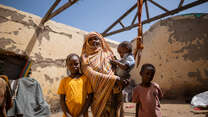The International Rescue Committee’s analysis and approach to COVID-19 draws on decades of experience as a humanitarian and health responder in the world’s most complex crises, including as one of the largest responders to the Ebola outbreaks in West Africa and the Democratic Republic of Congo and cholera in Yemen—the largest outbreaks of the diseases in modern history. The IRC’s experience finds conflict-affected and fragile countries face a double emergency:
- The direct impact of COVID-19 and its lethal and destructive direct impact on unprepared health care systems and populations with pre-existing vulnerabilities;
- The secondary havoc the disease will cause to these states’ already fragile humanitarian, economic, security and political environments.
COVID-19 is in the early stages of spreading to less developed and fragile countries, which means there is still time to mount a coordinated response that can ease suffering today and guard against dangerous secondary impacts tomorrow. But the time to act is now. Protracted economic, political and security crises have rendered many countries ill-equipped to respond to the disease.
The four countries discussed in this report—South Sudan, Syria, Venezuela and Yemen—as well as camps for displaced populations around the world have weakened health systems unable to meet existing needs. Nearly half (46%) of the people in those four countries already lack access to basic health services. While the United States and Europe face shortages of ventilators, intensive care units and protective equipment, many conflict-affected and fragile countries have virtually none to begin with:
- In South Sudan, there are just 24 ICU beds and four ventilators. With existing life-saving humanitarian programs globally facing unprecedented disruption and suspension, countries like South Sudan with high levels of malnutrition may face famine.
- Northeast Syria has only 28 ICU beds and 11 ventilators in the hospitals identified to quarantine and treat suspected COVID-19 cases. In Northwest Syria, there are only 105 ICU beds and 30 adult ventilators. Across Northern Syria, there were 85 attacks on health facilities last year alone and the country is likely to see further instability if we see actors like ISIS capitalizing on chaos to gain further ground.
- In Yemen, only half of the hospitals are still fully functional and some two-thirds of the population cannot access healthcare. It is one of the most complex operating environments for humanitarians, with bureaucratic delays and impediments already slowing the response. Major donors have also begun to reduce and suspend aid in northern Yemen just as the pandemic began, which could further degrade preparedness and response.
- In Venezuela, the existing humanitarian crisis has already forced more than half of doctors to leave the country, 9 out of 10 hospitals to face shortages of medicine and critical supplies, and left only 84 ICU beds nationwide. The country will likely face further economic crisis and reductions in public services, which not only threaten the lives of millions of Venezuelans, but are likely to heighten political tensions.
- Meanwhile, camps in Syria, Greece and Bangladesh represent some of the most densely populated areas in the world—up to 8.5 times more densely populated than the Diamond Princes cruise ship, where transmission of the virus was four times faster than in Wuhan, China. In parts of Moria camp, Greece, over 1,300 people share one tap and over 200 share a latrine. Rohingya refugees in one site in Cox’s Bazar, Bangladesh could face 590,000 infections and over 2,100 deaths in a year if high transmission occurs, according to new research from Johns Hopkins.



